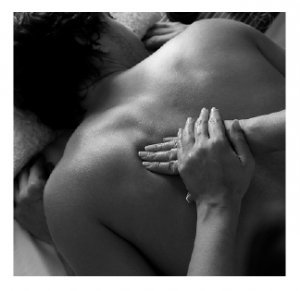What if you’re the caretaker or loved one of someone who suffers from chronic pain?
If you love or care for someone who lives with chronic pain, whether the result of illness or injury, all the more reason to pay attention to the careful sharing of touch.
 Living with Chronic Pain
Living with Chronic Pain
I have a friend who underwent back surgery some years ago. He endured months of physical therapy, pain management medication and procedures, and followed every doctor’s order. He still lives with chronic pain; it colors every aspect of his life. He handles it far more gracefully than I would.
But the unspoken element is the shift in personal relationships. All too often, sexuality drifts away, along with the emotional benefits that come with intimacy and well-being.
I have also lived this experience – years that Fibromyalgia had me achy on good days and bedridden on the bad. During the worst of it my husband traveled, and wasn’t around to see how terrible I was feeling. Making matters more difficult, he was among those who said “it’s all in your head.” It certainly added distance to an already trying situation.
What I didn’t know enough to say then, I’ll say now:
A person in chronic pain remains a full person inside, and requires your understanding when it comes to family outings, fatigue from routine work, mood swings, traveling, lifting a child – and of course, sharing a sex life.
Those who are in pain must also remember that partners can’t possibly grasp what you’re going through, and they feel guilty for being healthy. So give them a break.
Share a sex life, if at all possible
I’m all for creativity – in everything! And acts of love are no exception. Think of this as your opportunity to experiment. Eroticism begins in the mind – with images, words, scents, memories, music, a whisper, a surprise…
 Even with physical challenges, you have options. And if you care for someone who lives with pain, or you live with chronic pain – that most intimate sexual connection – however it is accomplished and to whatever extent – will do a world of good, for both of you.
Even with physical challenges, you have options. And if you care for someone who lives with pain, or you live with chronic pain – that most intimate sexual connection – however it is accomplished and to whatever extent – will do a world of good, for both of you.
Please remember – I am not a health care professional or a therapist. This is a personal interpretation drawn from my experience and that of friends.
Opportunities for Tender Touch:
Something as simple as massage can be both soothing and sexual.
Massage followed by localized sexual contact – whether dealing with a man or a woman – can lessen the need for significant movement, while still providing a great deal of pleasure. In other words, use your hands or mouth on your partner.
Inspired positioning can also be a solution. For a man with back problems, a sitting position, in a comfortable chair with good support (leaned against a heating pad if that assists and is doctor-approved), will allow your partner to do the rest – again, with the hand or the mouth.
If your partner is agile enough (and the chair sufficiently sturdy!) she may seat herself facing you, and use the strength in her legs to provide a very engaging sexual experience – a position for everyone to enjoy!
Or if more comfortable, reclining on pillows may be just the thing.
If the woman suffers from chronic back pain, she may lie on a heating pad (with something between her skin and the source of heat to prevent burns), or prop herself in a way that there is little to no pain. Her partner may be able to enjoy a variety of playful and pleasurable activities for both, including the visual stimulation of seeing her, and his enthusiastic response.
Get Creative! Make Contact Playful
Play with food! With scrabble tiles! Cool surfaces and varying textures are the stuff of delicious responses. And sexual contact is at least as much about the mind’s willingness to let go and enjoy emotional connection. Living and loving with chronic pain doesn’t mean giving up fun.
And let’s not forget the delights and power of kissing. Lips are extraordinarily sensitive, and the kiss remains one of the most romantic and intimate gestures we have to share with those we love.
Physical closeness – lying together, kissing – expresses so much more than sexuality. It communicates love, connection, tenderness. And don’t leave it to the lips alone. Hold hands, touch your partner’s face. Remember fingers and fingertips as well as nipples – both a man’s and a woman’s are extraordinarily sensitive to pleasure, along with so many parts of the body.
And much of this requires very little movement on the part of the partner who otherwise might be in pain.
Pain breeds depression and isolation reinforces it. Loss of sexuality and simple acts of affection will worsen the situation. Not only for the one who suffers from chronic pain, but for the partner, and the relationship.
Medications and Sexual Performance Problems
Superstud performance is not a requirement for intimacy. We have our prime, and we have our autumn. If pain or medications reduce sexual capacity, creativity can jazz up the evening with foreplay, wordplay, and pleasuring the other.
 What thought would I like to leave you with?
What thought would I like to leave you with?
Communication helps everything. Talk. Write. Tell your partner what feels good. Ask for what you need.
If you don’t ask, you’re sure not to get it.
Just because we live in pain – and sometimes we can’t help but show it – doesn’t mean we are any less worthy of your love, your respect, or human contact.
We may need creative solutions to logistics, but we are still here. And touch, handled in a caring way as well as sexual, is all the more important. It is humanizing. It reminds us, even if momentarily, that we are still ourselves.
Read the full text of Living and Loving with Chronic Pain (June 20, 2009).
Leave a Reply